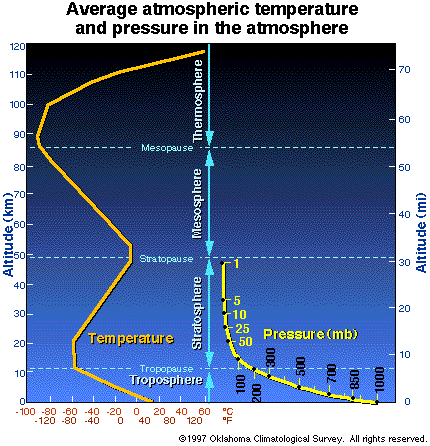|
|
Vertical Structure of the Atmosphere
Part 2
|
|
|
|
|
|
|
Principle
|
The changes in the atmosphere with height
are results of specific physical conditions which exist on
the earth and in its atmosphere. The vertical changes in
temperature are important in constraining weather events to
the lowest 10-12 km of the atmosphere. The ozone layer,
located near 25 km above the earth's surface, causes the
temperature to rapidly change in the middle
atmosphere.
|
|
|
|
|
|
|
Figure 2 - Relationship Between Pressure and Height in
the Atmosphere
|
|
|

|
|
|
Changes in Air Pressure with Height
|
- Pressure always decreases with height and does so
most rapidly near the ground. Why do sealed balloons
increase in volume when they rise in the atmosphere? Why
do your ears "pop" when you ride on an elevator in a tall
building or when you take off in an airplane?
As we move upward in the
atmosphere, the weight of the air upon us should decrease
because there is less air above us. Thus, air pressure
decreases with increasing height.
- Pressure decreases with height more rapidly near the
ground because the atmosphere is a gas which can compress
in its response to the earth's gravitation effect.
- If more air is packed into the
same length vertical column, then the air column will
weigh more and, hence, the air pressure will be greater.
So we may have horizontal
variations of pressure if two air columns are next to one
another, both of the same height but one with more
molecules packed into it than the other. This is how we
get high and low pressure systems.
- The rate at which air pressure
changes with height is determined primarily by the
average temperature in the column under
consideration.
In colder regions, atmospheric
pressure decreases more rapidly with height than normal
or than is observed in warmer areas.
|
|
|
|
|
|
|
Changes in Air Temperature with Height
|
- Temperature has a more
complicated structure, mostly because the temperature of
the air relies on the energy its molecules receive from
radiation.
The two main sources of
radiation in the atmosphere are the sun and the earth.
The sun's radiation is mostly near infrared (37%),
visible (44%), and ultraviolet (7%) while the earth's
radiation is mostly far infrared. Infrared is generally
what we feel as "heat", visible is what we see, and
ultraviolet is what our skin absorbs to make us tan or
burn. The temperature structure of the atmosphere is
controlled significantly by whichever of these three
types of radiation are affecting the region.
- Temperature generally decreases
with height in the lowest 10 km or so above the earth's
surface.
This 'layer' is called the
troposphere. How can we tell temperature decreases with
height? Do mountains give us a clue?
- Temperature increases with
height from about 10 km to 50 km above the earth's
surface.
This layer is called the
stratosphere and results from absorption of solar
radiation by ozone. How can we "see" the change from the
troposphere to the stratosphere? The tops of large
thunderstorm clouds can show us.
- Temperature again decreases and
increases with height above the stratosphere.
These layers are called the
mesosphere and thermosphere, respectively.
|
|
|
|
|
|
|
|

|
